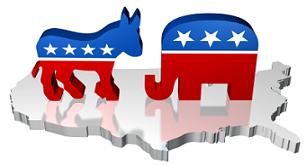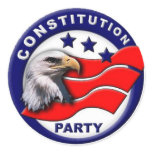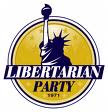Most people think about the US political system as "bipartisan". They get that impression because two major political parties, the Democratic Party and the Republican Party have shared political power since independence, particularly alternating on the Executive Power.

While many realize that "third party" candidates occassionally appear in the ballots, most people call them "independents" and believe that such parties are shortlived, even if they deserve to be called "parties" at all.
Such an impression on US masses derives from the fact that the US electoral system is not proportional and the winner takes all. In winner-take-all (or plurality-take-all) systems, the candidate with the largest number of votes wins, even if the margin of victory is extremely narrow or the proportion of votes received is not an absolute majority. Therefore, third parties or so called independent candidates are seldom elected to Congress, because only the candidates with the higher number of votes in their State or Disctrict are elected to the Senate or the House of Representatives respectively. And they have never succeeded in having their Presidential candidate elected unless they entered the polls in support of one of the major parties candidate.
However, the truth is that US democracy is a multiparty system with many active political institutions trying to make space for their programs and candidates. Besides the two major parties, some 40 additional parties are registered and listed in the "Directory of US Political Parties". Among them, the Constitution Party, the Green Party of the United States and the Libertarian Party have achieved high vote performances over the past two election cycles. Some prominent figures from these three parties, such as Pat Buchanan, Ralph Nader and Ronald "Ron" Paul, among others, are well known to US voters. Practically all these parties have a clearcut platform that is discernible by any voter and they offer distinctive programs of government and policy solutions to US problems.



However, many voters will be surprised to know how radical the platform and programs of some of these "third parties" are. While many of them are not discernible just by the meaning of their name, others are, such as the American Nazy Party, the Communist Party USA, the Freedom Socialist Party, the National Socialist Movement, the Party for Socialism and Liberation, the Peace and Freedom Party, the Socialist Party USA, the Socialist Action, the Socialist Equality Party, the Socialist Labor Party, the Socialist Workers Party, the US Pacifist Party, the Revolutionary Communist Party USA, and a few others.
Apart from the two Nazy parties openly racial, socialist and totalitarian preferences, the Communist/Socialist parties listed above reflect Fabian, Leninist, Marxist, Maoist and Trostkyist doctrines (readers may open the links in the two previous paragraphs to find out), but they are all allowed to act freely in the US democratic process. However, some of them support ideologies that clearly depart from democratic norms and principles. Despite the forced transformation resulting from the demise of the Soviet Empire, the Communist Party USA clearly underlies their Marxist ideology and a program to abolish corporate "monopolies", to promote public ownership of basic industries, to impose huge tax hikes for corporations and the wealthy and several other plans to "beat the power of the capitalist class ... and to promote freedom struggles around the world". On its part, the Party for Socialism and Liberation promotes itself "to be a vehicle for the multinational working clas in the struggle for socialism", and they conclude that "we aim for revolution in the United States". Another similar example we find at the Freedom Socialist Party website proclaiming that the "party is a revolutionary, socialist, feminist organization, dedicated to the replacement of capitalist rule by a genuine workers' democracy" and that "the working class is international".
These radical parties support many front organizations such as International Action Center (“anti-capitalist” and “anti-imperialist” organization supporting governments such as Cuba and North Korea, among others), Stop War on Iran (not a typo; they are in fact campaigning against "US aggression" to Iran), May 1st Coalition for Worker and Immigrant Rights (organized as a social network), Young Communist League, International ANSWER (an acronym for "Act Now to Stop War and End Racism" and functioning under the direction of Ramsey Clark, who served under Kennedy and Johnson as Attorney General), and dozens more.
Third parties seldom succeed in electing members to Congress. When they do, it is usually a candidate that has defected from one of the two major parties and receives support from one or several third parties but at the same time is able to get enough votes from his or her former party's constituents to win.
Third party presidential candidates seldom get more than 1% of the vote, with a few exceptions such as Ross Perot, who founded the Reform Party, and was able to run in all 50 States. He received in 1992 almost 19% of the vote, establishing a record since Theodore Roosevelt obtained 27% of the vote at the head of the Progressive Party in 1912. Presidential elections are decided by the sum of the "electoral votes" assigned to each State according to population. Because of the winner-take-all (or plurality-take-all) system, it is extremely rare that a third party presidential candidate gets any "electoral" votes at all. Theodore Roosevelt 88 out of 435 electoral votes in 1912 was the most prominent of the few exceptions to this rule in US history.
The two major parties do not differ widely on their strategy and/or ideology. The Democratic Party leans towards moderate Socialist programs (so called "liberal" in the United States) and favors further centralization of government, while the Republican Party mostly embraces conservative solutions to economic policies (referred as "neoliberal" in Europe) and promotes a reduction of government power and less interference in the life and habits of US citizens and residents. They might be compared to "centrist" European parties, with the Democrats closer to the European Socialists or Social Democratic parties and the Republicans to the European Popular Parties.
Comments powered by CComment